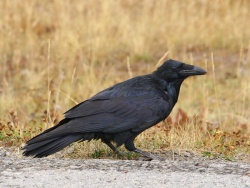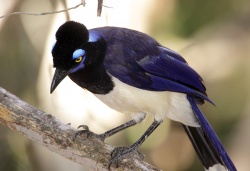Nutcracker (talk | contribs) m (format) |
(update due to split) |
||
| (One intermediate revision by the same user not shown) | |||
| Line 8: | Line 8: | ||
* stiffened primaries and tail feathers | * stiffened primaries and tail feathers | ||
* tuft of nasal bristles extending to the nostril opening | * tuft of nasal bristles extending to the nostril opening | ||
| − | * an unspotted juvenile plumage | + | * an unspotted juvenile plumage |
The body size in this family is quite variable. Ravens and crows can be quite large whereas jays and magpies are only medium-sized. The [[Common Raven]] is the largest passerine in the world, reaching 69 cm in length and 2 kg in weight. On the other hand the [[Dwarf Jay]] of Mexico with 20 cm and 40 g is the smallest corvid.<br /> | The body size in this family is quite variable. Ravens and crows can be quite large whereas jays and magpies are only medium-sized. The [[Common Raven]] is the largest passerine in the world, reaching 69 cm in length and 2 kg in weight. On the other hand the [[Dwarf Jay]] of Mexico with 20 cm and 40 g is the smallest corvid.<br /> | ||
The corvids are one of the best-known avian groups and they have fascinated man for a long time. Images of them are found on cave wall paintings made by the early humans. Their curiosity, memory, attractive movement, varied vocalisations and ecological plasticity have intrigued people around the world. | The corvids are one of the best-known avian groups and they have fascinated man for a long time. Images of them are found on cave wall paintings made by the early humans. Their curiosity, memory, attractive movement, varied vocalisations and ecological plasticity have intrigued people around the world. | ||
| Line 15: | Line 15: | ||
Corvidae is a family in the order [[:Category:Passeriformes|Passeriformes]].<br /> | Corvidae is a family in the order [[:Category:Passeriformes|Passeriformes]].<br /> | ||
Studies indicate that the family is monophyletic which means that all corvids have the same ancestor. This species lived most probably in today's Australia some 53 million years ago.<br /> | Studies indicate that the family is monophyletic which means that all corvids have the same ancestor. This species lived most probably in today's Australia some 53 million years ago.<br /> | ||
| − | The relationsship within the other avian families has been discussed for a long time. New work indicate that the [[:Category:Paradisaeidae|Birds-of-paradise]] are the sister-group of the corvids and that the [[:Category:Ptilonorhynchidae|Bowerbirds]], the [[:Category:Laniidae|Shrikes]] and the [[:Category:Vireonidae|Vireos]] are also closely related to them | + | The relationsship within the other avian families has been discussed for a long time. New work indicate that the [[:Category:Paradisaeidae|Birds-of-paradise]] are the sister-group of the corvids and that the [[:Category:Ptilonorhynchidae|Bowerbirds]], the [[:Category:Laniidae|Shrikes]] and the [[:Category:Vireonidae|Vireos]] are also closely related to them. |
| − | |||
{{Nav-Corvidae}} | {{Nav-Corvidae}} | ||
==References== | ==References== | ||
| − | #{{Ref- | + | #{{Ref-Clements6thOct23}}#{{Ref-GillDonskerRasmussen24V14.2}}#{{Ref-HBWVol14}} |
{{Ref}} | {{Ref}} | ||
[[Category: Passeriformes]] | [[Category: Passeriformes]] | ||
Latest revision as of 23:28, 7 November 2024
Family: Corvidae
Description
Around 125 species of crows, jays and magpies are found worldwide. They inhabit all continents except Antarctica.
Basic features of the corvids are:
- long tarsi
- stiffened primaries and tail feathers
- tuft of nasal bristles extending to the nostril opening
- an unspotted juvenile plumage
The body size in this family is quite variable. Ravens and crows can be quite large whereas jays and magpies are only medium-sized. The Common Raven is the largest passerine in the world, reaching 69 cm in length and 2 kg in weight. On the other hand the Dwarf Jay of Mexico with 20 cm and 40 g is the smallest corvid.
The corvids are one of the best-known avian groups and they have fascinated man for a long time. Images of them are found on cave wall paintings made by the early humans. Their curiosity, memory, attractive movement, varied vocalisations and ecological plasticity have intrigued people around the world.
Taxonomy
Corvidae is a family in the order Passeriformes.
Studies indicate that the family is monophyletic which means that all corvids have the same ancestor. This species lived most probably in today's Australia some 53 million years ago.
The relationsship within the other avian families has been discussed for a long time. New work indicate that the Birds-of-paradise are the sister-group of the corvids and that the Bowerbirds, the Shrikes and the Vireos are also closely related to them.
References
- Clements, J. F., P. C. Rasmussen, T. S. Schulenberg, M. J. Iliff, T. A. Fredericks, J. A. Gerbracht, D. Lepage, A. Spencer, S. M. Billerman, B. L. Sullivan, and C. L. Wood. 2023. The eBird/Clements checklist of Birds of the World: v2023. Downloaded from https://www.birds.cornell.edu/clementschecklist/download/
- Gill, F, D Donsker, and P Rasmussen (Eds). 2024. IOC World Bird List (v 14.2). Doi 10.14344/IOC.ML.14.2. http://www.worldbirdnames.org/
- Del Hoyo, J, A Elliott, and D Christie, eds. 2009. Handbook of the Birds of the World. Volume 14: Bush-shrikes to Old World Sparrows. Barcelona: Lynx Edicions. ISBN 978-8496553507
Recommended Citation
- BirdForum Opus contributors. (2025) Corvidae. In: BirdForum, the forum for wild birds and birding. Retrieved 5 February 2025 from https://www.birdforum.net/opus/Corvidae
Subcategories
This category has the following 30 subcategories, out of 30 total.





